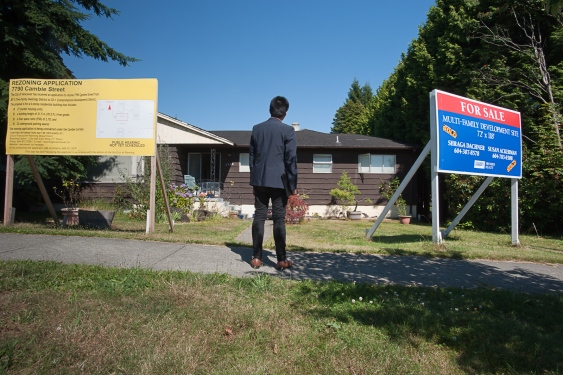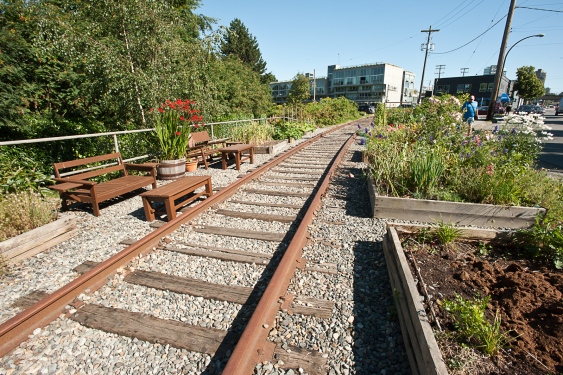Longtime residents of a family-oriented neighbourhood face massive change
Christopher Cheung
Van. Courier

Many houses on major Vancouver arterial routes like Cambie Street are advertised for condominium potential to attract developers. Photo Rob Newell.
Stan Carr has lived on east Marpole’s stretch of Cambie Street for almost half a century. The 89-year-old former fisherman and mechanic likes living there. He enjoys mowing his own lawn as he has done for years. He sits by the front door when the weather is nice.
His property has an open view of the neighbourhood, and these days also a view of new towers rising at the Cambie Street and Marine Drive intersection.
Carr doesn’t like to talk about the development, which promises a future of shops, offices and crowds, bringing rapid change to neighbourhoods that have long remained residential. “My opinion doesn’t matter,” he said. “It won’t change anything.”
The Canada Line was completed in August 2009 and the Marine Drive Station at the foot of Cambie brought more people to the neighbourhood, highlighting the area for development potential.
That’s when the offers from buyers first came in.
“I get many,” said Carr. “Knocking on the door, by mail, by phone.”
Carr’s parents purchased the duplex in the mid-1960s because his mother liked the area. He and his brother moved in not long after.
Carr remembers how quiet it was due to infrequent transit and the comparison with their previous home. He is Croatian and prior to Cambie Street lived in Grandview-Woodland near Templeton secondary with his parents and brother.
“Most of Croatian people that came [to Vancouver] were in East Van and we all knew each other,” said Carr. “It was like a family.”
On Cambie, Carr only knows a few neighbours. The land in this area is zoned for two-family dwellings, hence the abundance of duplexes, and many rent out one or both sides.
Carr remembers residents next door never stayed long. “They were moving out like it was Grand Central Station.”
As a result, many duplexes on Cambie have lawns with tall grass and weeds. “That’s how you know it’s a rental property,” said Carr.
Carr is predeceased by his parents and brother. He lives alone but still tends to the family house with care. He does less today but for many years took care of the plumbing and roofing.
Carr has received good offers for the house but has rejected them all. There are many family memories here.
“They’re paying some crazy prices for these houses. Anywhere between three and four million. You could buy a much nicer house than this one, but I just don’t like to move.
“At my age, money doesn’t matter.”
Vanishing charm
The Marpole Community Plan, adopted by city council April 2, promises to “minimize change to single-family areas… about 85 per cent of existing single-family zoned areas will not change.” The remaining 15 per cent that will change is “near major streets where transit, shops and services are available”.
This happens to be Carr’s neighbourhood.
The three towers under construction at Marine Landing are PCI Group’s Marine Gateway, Intracorp’s MC2 and Onni Group’s Northwest.
In April 2012, all of Marine Gateway’s 415 residential units sold within four hours.
Jonathan Tsang, a Burnaby resident, comes to the area often to visit his mother. Tsang is a friend of Carr and always stops by for a chat afterward.
Tsang has noticed the rezoning of properties along the Cambie Corridor over the years. “It has already started happening near Oakridge,” he said. “All the local people are forced to move away.”
Buffalo Investment’s Aperture and Mosaic’s Cambria are apartment projects near Oakridge Centre situated on rezoned single-family dwellings.
Joanna Teja comes to Vancouver every year from Zanzibar to visit her daughter who lives in a duplex along the corridor. She has watched the neighbourhood change over the years.
“Prices keep going up and highrises keep going up,” said Teja. “Just because these are old areas doesn’t mean they have to be torn down.”
Teja likes the familial, neighbourhood charm of the cul-de-sacs and schools in the Marpole and Oakridge areas. She worries about their future with Vancouver’s increasing density. “People looking for smaller neighbourhoods can’t find them anymore. The increasing population is dictating the changes.”
Hot market
Eddy Chan owns a duplex near Carr and has also received many offers and inquiries about selling. He and his wife have decided to stay for now. Chan is indifferent to the changes and hurried turnover of real estate as he understands he lives in a prime location.
“It’s development,” said Chan, “and development needs houses.”
Johnny Tse, a renter, also understands the area’s desirability.
“It’s just business,” Tse said of the rezoning and development. “Whatever the government decides goes.”
His rent is affordable, despite having gone up a few times during his seven years in the area. But Tse said he will move away if changes prove too extreme.
Houses that are on the market do not have typical realty signs. They are advertised as multi-family development sites on massive boards with stakes driven into lawns. Some properties have a pair of signs to face each direction of the road. They are often accompanied by equally large notices displaying rezoning applications.
Amex Fraseridge Realty lists 7638 Cambie St., a duplex, with “investors/builders alert” and “potential six-storey apartment.” The sale price is $3,898,000.
Marine Gateway plans to support the density with retailers and services including restaurants, banks, pharmacies, a supermarket and theatre to be completed in 2015.
“The area will not be good for families with children,” said Chan. “There’s just too much traffic.”
Even with the new conveniences at Marine Gateway, Carr will not benefit. “It’s far for me because I can’t walk that far anymore.”
As Carr and Tsang enjoy each other’s company sitting in front of Carr’s green lawn, both know open yards and wide, flat homes like this one won’t be around for long.
“Vancouver is getting bigger with no space to go but up,” said Carr. “What can you do?”
Rezoning applications on the Cambie Corridor:
6311 Cambie St. (Enacted March 2012)
- six-storey building
- 4 commercial units
- 51 residential units
516 W 50th Ave. and 6629-6709 Cambie St. (Approved December 2013)
- two six-storey buildings and two two-storey townhouses
- 128 residential units
- 132 underground parking spaces
7645 Cambie St. and 506 W 60th Ave. (Proposed)
- one six-storey residential building
- one six-storey mixed use building
- 138 secured market rental units
- a church assembly space
- underground parking spaces
7790 Cambie St. (Proposed)
- six-storey building
- 27 market housing units
- 23 underground parking spaces
8175 Cambie St., 519 SW Marine Dr., and 8180-8192 Lord St. (Approved January 2014)
- one 31-storey tower, one 12-storey tower, three-storey building with daycare and community amenity space
- 368 residential units
- 1,365-square-metre commercial retail space
- 387 underground parking spaces
© Vancouver Courier



